External Features Unique to Laptops
Laptops, in essence, are portable computing devices, typically operating on full-fledged operating systems like Microsoft Windows, MacOS, or Linux.
Laptops can possess computing power and memory resources comparable to that of desktop computers. Illustrated in the diagram, laptops consolidate a display, keyboard, and a pointing mechanism, such as a touchpad, into a single portable unit. They can operate on internal batteries or be powered via an electrical outlet. They provide connectivity choices, including wired or wireless Ethernet networking and Bluetooth.

Laptops furnish a variety of device connection alternatives like USB and HDMI. Many laptops also feature audio input and output connections. Certain laptops facilitate graphic connections using various graphics standards, similar to desktops. However, for enhanced portability, certain peripheral connection options might necessitate additional hardware, such as a dock or port replicator.
In pursuit of greater portability, laptops might make certain concessions in comparison to the advantages offered by desktop computers. For instance, they may not employ the swiftest processors available, primarily due to concerns related to cooling and high power consumption.
Upgrading memory in laptops may have limitations, and some types of laptop memory can be pricier than equivalent desktop memory. Laptops also lack the expansion capabilities inherent to desktops. Specialized expansion cards and extensive storage solutions often cannot be installed in laptops. For example, upgrading the graphics subsystem in a laptop is often a formidable challenge.
Laptops are versatile devices with a variety of external features that set them apart from other computing devices. Here are some unique external features commonly found on laptops:

- Lid: The lid or cover of a laptop is designed to protect the screen when the device is not in use. It can often be opened and closed to access the laptop’s display.
- Secure Digital Multi Media Card Reader (SD/MMC Card Reader): Many laptops come equipped with built-in card readers that allow you to read data from SD and MMC memory cards, commonly used in digital cameras and other devices.
- Ventilation Grill: Laptops generate heat during operation, and ventilation grills are designed to dissipate this heat and keep the internal components cool. They are usually located on the bottom or sides of the laptop.
- Ports: Laptops typically have a variety of ports for connecting external devices. Common ports include USB, HDMI, VGA, Ethernet, and audio jacks. These ports facilitate connectivity with peripherals like external monitors, mice, keyboards, and more.
- Security Key Holes: Some laptops have security keyholes that allow you to physically lock the laptop to a stationary object using a compatible security cable. This helps prevent theft or unauthorized removal.
- PC Card Slot: While less common in modern laptops, some older models featured PC Card slots that allowed for expansion with PCMCIA cards for additional functionality.
- DVD-RW Drive: Many laptops have built-in DVD-RW drives that can read and write DVDs and CDs. However, with the rise of digital downloads and cloud storage, these drives are becoming less common in newer laptops.
- Ethernet and Phone Jacks: Laptops often have Ethernet ports for wired internet connectivity and phone jacks for connecting to analog phone lines. These connections can be useful in situations where wireless connectivity is not available or reliable.
- Battery: Laptops are designed to be portable, and a built-in rechargeable battery provides power when you’re not connected to a power outlet. Battery life can vary widely depending on the laptop’s specifications and usage.
- RAM Access Control: Some laptops allow you to access and upgrade the RAM (Random Access Memory) for improved performance. Access panels or slots are provided for this purpose.
- Wireless Card Access Control: Access panels or slots may also be present for accessing and upgrading the laptop’s wireless network card, such as Wi-Fi or Bluetooth modules.
- Hard Drive Access Control: Similar to RAM and wireless card access, some laptops offer access panels or slots for upgrading or replacing the internal hard drive or solid-state drive (SSD).
These external features contribute to the functionality and versatility of laptops, making them suitable for a wide range of tasks and environments, whether you’re using them for work, entertainment, or on-the-go computing.



